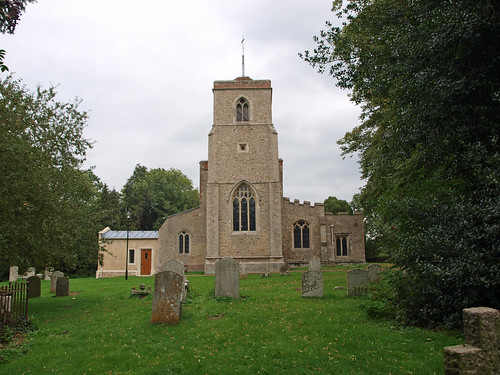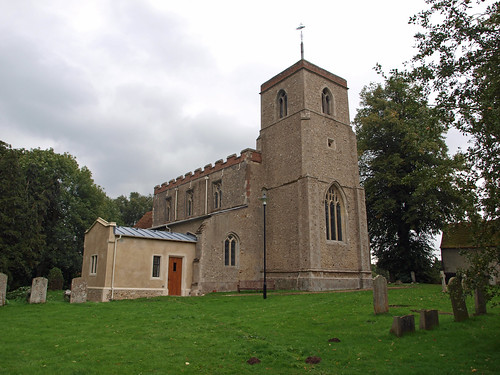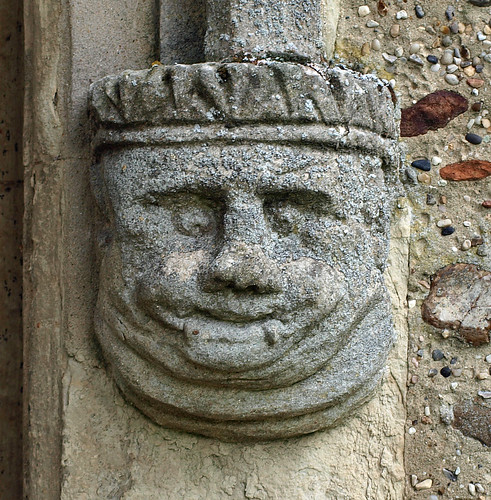St Andrew is very peculiar and is not helped by a, seemingly, very new, north extension; because it's so odd it is logically locked with no keyholder listed. I've Googled it and can't find anything particularly informative.
The south aisle and porch are embattled while the north aisle isn't but the nave is, a tiny chancel is tacked on to the end and a four stage tower sits four square to the world. The new extension will age well and only adds to the eccentricity of the church.
ST ANDREW. An early C14 church. But the most unusual motif is the straightheaded two-and three-light windows with a kind of reticulated tracery straightened out, and these are Early Perp, i.e. later C14. In the chancel and the N aisle some earlier C14 windows. The Sedilia with cusped arches on polygonal shafts and no ogee forms also is early C14. W tower with clasping buttresses and a three-light W window. The arcades to the N and S aisles rest on piers with four major and four keeled minor shafts. The arches are two-centred and have head-stops. The most remarkable feature of the church however is its three large and almost identical tomb-recesses, one in the N aisle, one in the S wall of the chancel, and one in the S aisle. There is no effigy or record on any of them to tell us who had them erected. Two hold tomb-chests with indents for brass figures. All three have canopies with thin buttresses and large cusped arches and ogee gables with crockets and finials. In the gables of two is a quatrefoil in a circle. The third has the quatrefoil cusped. The one in the chancel moreover has to the l. and r. of the gable large shields. The S aisle recess seems the earliest, the chancel recess the latest; but all three must be C14. - FONT. Octagonal. Traceried stem, bowl with two small quatrefoils with shields in each panel. - SCREEN with simple traceried lights. - S DOOR with much tracery; C14. - STALLS (W end of nave). Two with poppy-heads. - COMMUNION RAIL, c. 1700, with twisted balusters. - STAINED GLASS. Many bits, especially in the E window - the arms of the Norwood family and its alliances; C14. - STRAW DECORATION for the altar, premiated at an 1872 exhibition in London. PLATE. Small Cup and Paten of 1562.
SHALFORD. Its many old buildings include a farm which has an overhanging storey above the porch, and a Tudor door with ornamental ironwork; but for Shalford’s treasures we cross a field to the church standing in a quiet valley. Its tower is 15th century, but nearly everything else we see is a hundred years older, the porch with shields and grotesques in its roof, the beautiful traceried door, and the arches and clerestory windows which make the interior so impressive. The handsome altar rails are 17th century, and so is the nave roof, but there are other beams 600 years old, and a splendid chancel screen which has been with them all the time. It has little openings in the lower panels, at which a child might kneel and look through at the altar; and at the back of the screen are two Tudor stalls, and a panelled desk with a pelican on one of its poppyheads.
The east window has fine glass as old as the church, showing shields of arms, lions, and foliage; and there are shields and other fragments in the windows of the aisles. A peephole is 15th century, and so is the font, which has the arms of such famous families as the Mortimers, De Veres, and Fitzwalters. There is much notable stone carving by the 14th century men, the chancel having three handsome sedilia and a very fine recess with an altar tomb. Two other beautiful recesses are in the aisles, and on the sanctuary wall is a brass of William Bigge and his wife, from the England Shakespeare knew.
Flickr.



No comments:
Post a Comment